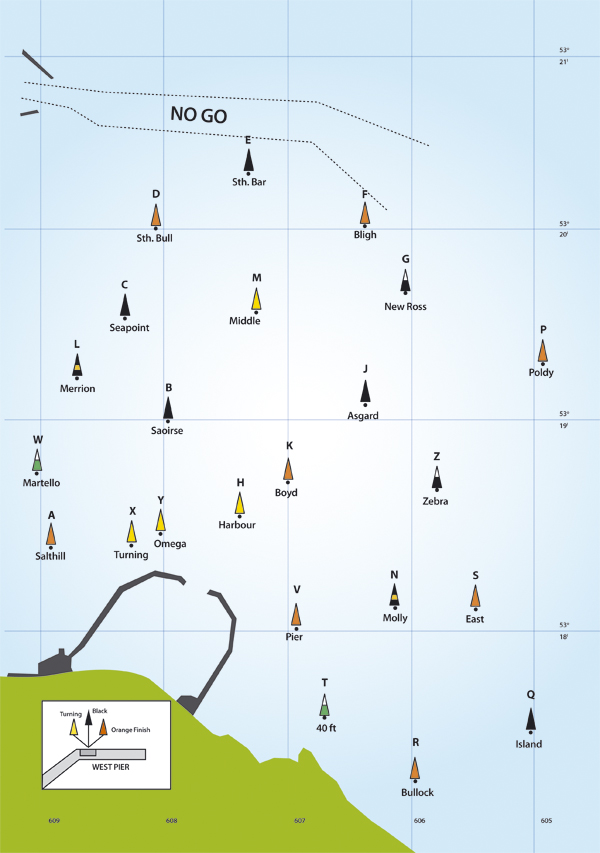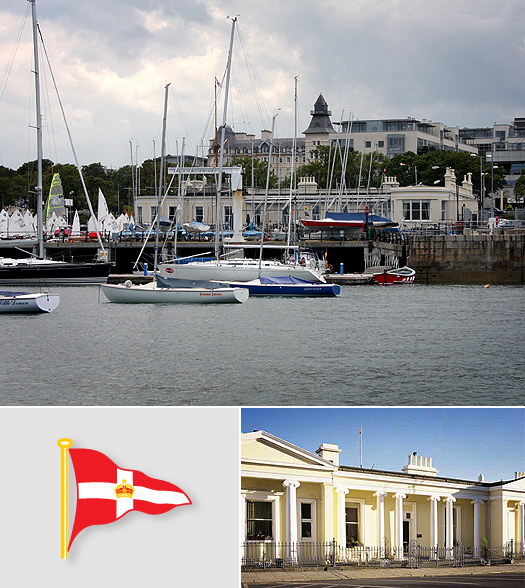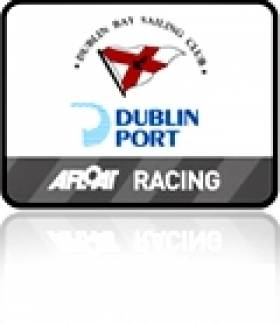Displaying items by tag: Dun Laoghaire
Dublin Bay Sailing Club Unveil New Courses Tomorrow
Dublin Bay Sailing Club (DBSC) has unveiled a range of new courses for its new summer sailing season, the biggest in the country, that starts tomorrow. Arising out of congestion on Thursday's evening races the club has been motivated to separate its blue and red fleets that total nearly 300 boats. Hon Secretary Donal O'Sullivan says there is very little sign of any recessionary drop off among its 1700 members, an indication, were it needed, there is still high demand for local racing on the capital's waters.
There are 17 keelboat fleets, each racing at different speeds, so separating classes is no easy job.
The first of the current phase of course changes happened in 2001 when DBSC acquired a committee boat, MacLir, that has given great flexibility to course changing afloat. Then in 2003 there was a major overhaul and now for next Saturday's first race, building on the experience of the intervening years, there is a 2010 model.
Two new marks have been introduced, Merrion in Seapoint Bay and Molly near Scotsman's Bay to combat the problem, other marks have been moved. (see chart over the fold).
The Blue fleet (Cruiser classes 0, 1,2,3, 31.7s Sigmas and White sail boats) will race in the upper northern part of the racing area on Thursdays.
The overall shape or pattern of the courses remains the same. As before, there will be blue, red and green divisions, with alternating West Pier Hut and MacLir starts.
"The big change is that in order to limit as much as possible the intermingling of different fleets, the blue fleet will tend to race most of the time in the upper, northern section of the racing area while the red fleet will race in the lower, southern section" says new commodore Tony Fox.
On the dinghy course, there are exciting changes as well. This year, besides the usual triangular or windward/leeward courses race officers will be able to select a trapezoid course. This could pose interesting problems for mark-layers but the dinghy organisers have, not unexpectedly, anticipated this. There have been training courses, marks will be laid using GPS, and the team have access to a dedicated website with training videos.

Graphic Design and Printing
Graphic Design and Printing Service
Don't miss out on promoting your business.
Afloat magazine serves as the voice of the marine industry but we offer a design, typesetting, and website printing service too.
From simple stationery items and logos to complex website design and full colour brochures, we offer special discounts to firms in the marine industry.
Please call for a quotation. No job too small. Tel: 01 284 6161 or 01 2020 374.
National Yacht Club (NYC)

For all the latest news from the National Yacht Club click HERE
The Club
Founded on loyal membership, the NYC enjoys a family ethos and a strong fellowship which binds our members in a relaxed atmosphere of support and friendship.
Bathing in the gentle waterfront ambience of Dun Laoghaire on the edge of South County Dublin, the National Yacht Club has graced the waters of the Irish Sea and far beyond for more than a century.
Our famous burgee is a familiar sight in the sailing waters of Ireland, and the proud victory roll of our individual members and our Club is second to none.
Sailing Facilities
A slipway directly accessing Dun Laoghaire Harbour, over eighty club moorings, platform parking, fuelling, watering and crane-lifting ensure that we are excellently equipped to cater for all the needs of the contemporary sailor.
History
Although there are references to an active ‘club’ prior to 1870, history records that the present clubhouse was erected in 1870 at a cost of £4,000 to a design by William Sterling and the Kingstown Royal Harbour Boat Club was registered with Lloyds in the same year. By 1872 the name had been changed to the Kingston Harbour Boat Club and this change was registered at Lloyds.
In 1881 the premises were purchased by a Captain Peacocke and others who formed a proprietary club called the Kingstown Harbour Yacht Club again registered at Lloyds. Some six years later in 1877 the building again changed hands being bought by a Mr Charles Barrington. and between 1877 and 1901 the club was very active and operated for a while as the 'Absolute Club' although this change of name was never registered. In 1901 the lease was purchased by three trustees who registered it as the Edward Yacht Club.
In 1930 at a time when the Edward Yacht Club was relatively inactive, a committee including The Earl of Granard approached the trustees with a proposition to form the National Yacht Club. The Earl of Granard had been Commodore of the North Shannon YC and was a senator in the W.T. Cosgrave government. An agreement was reached, the National Yacht Club was registered at Lloyds, and The Earl of Granard became the first Commodore.
Sterling’s design for the exterior of the club was a hybrid French Chateau and eighteenth century Garden Pavilion and today as a Class A restricted building it continues to provide elegant dining and bar facilities. An early drawing of the building shows viewing balconies on the roof and the waterfront façade.
Subsequent additions of platforms and a new slip to the seaward side and most recently the construction of new changing rooms, offices and boathouse provide state of the art facilities, capable of coping with major international and world championship events. The club provides a wide range of sailing facilities, from Junior training to family cruising, dinghy sailing to offshore racing and caters for most major classes of dinghies, one design keelboats, sports boats and cruiser racers. It provides training facilities within the ISA Youth Sailing Scheme and National Power Boat Schemes.
The club is particularly active in dinghy and keelboat one design racing and has hosted two World Championships in recent years including the Flying Fifteen Worlds in 2003.
Berths with diesel, water, power and overnight facilities are available to cruising yachtsmen with shopping facilities being a short walk away. The club is active throughout the year with full dining and bar facilities and winter activities include bridge, snooker, quiz nights, wine tasting and special events.
Membership – enquiries may be addressed to: The Membership Secretary, The National Yacht Club – email: [email protected]
Reciprocal Clubs – The National Yacht Club has formal reciprocal membership arrangements with other clubs in Ireland and overseas. National Yacht Club members are welcome to visit our partner clubs and on introduction with the National Yacht Club membership card, our members may use the facilities of the host club subject to that club’s house rules. Likewise members of our reciprocal clubs are most welcome to visit the National Yacht Club where they may enjoy our facilities in the company of like-minded members.
Courses Offered – DINGHY: Up to Improving Skills, Advanced Boat Handling, Racing 1, Kites & Wires 1, and Adventure 1. POWERBOAT: 1, 2, and Safety Boat. KEELBOAT: Up to Improving Skills, Advanced Boat Handling, Racing 1, Kites & Wires 1, and Adventure 1.
(Details and photograph courtesy of the National Yacht Club)
National Yacht Club, Harbour Road, Dun Laoghaire, Co. Dublin. Tel: 01 280 5725, fax: 01 280 7837, email: [email protected] or [email protected]
Royal St. George Yacht Club

History
The Kingstown Boat Club, from which the Royal St. George Yacht Club evolved, was founded in 1838 by a small group of boating enthusiasts who had decided that ‘the (River) Liffey was every year becoming fouler and less agreeable for aquatic pursuits’.
They applied to the Commissioner for Public Works, and were granted a piece of ground near Dun Laoghaire Harbour on which to build a clubhouse – the first privately owned building to stand on publicly owned space. Initially, the members’ main interest was in rowing, but membership grew rapidly, and amongst them were many well-known yachtsmen of the day.
One of these was the Marquis Conyngham, who used his influence with Queen Victoria to have the privileges of a Royal Yacht Club conferred in 1845. The Club flag was to be 'the Red Ensign with a crown in the centre of the Jack' and the Burgee was red with a white cross with a crown at the centre. This, of course, is the St. George’s Cross, and is quite possibly the reason why, in 1847, the Club became The Royal St. George’s Yacht Club, although this has never been established. It subsequently became the Royal St George Yacht Club; it is referred to by all who know it, as simply ‘the George’.
Click for the latest Royal St.George Yacht Club news
The Clubhouse
The clubhouse was designed by Mulvany, a follower of Gandon, designer of the Custom House in Dublin, and he produced a beautiful miniature Palladian villa in the neo-classical style.
The builder was Masterson, who built many other beautiful houses in the neighbourhood, including Sorrento Terrace, Dalkey. Work was completed in 1843, but, incredibly, such was the growth in membership, that the clubhouse was already too small. Permission was granted by the Harbour Commissioners in 1845 for an extension of the original façade, which involved clever duplication of the existing Ionic portico with the erection of a linking colonnade between. The symmetry and classical grace of the clubhouse was thus preserved in the new building.
The George has a long tradition of racing and cruising, and members have, from the start, made their mark in home and international waters. In 1851, the Marquis Conyngham, Commodore, competed in his 218 ton yacht Constance in the Royal Yacht Squadron Regatta. An American yacht called America won the race! In 1893 William Jameson, of the eponymous distilling family, was asked by Edward, Prince of Wales, to be sailing master on his new yacht Britannia. He won 33 out of 43 starts in her first season.
In 1963 a major restoration project was undertaken to repair and update the Club’s facilities, and this attracted a large number of new members who were ultimately to pave the way for the later developments, including a much-envied multi-purpose club room, a state-of-the-art forecourt extension for dinghies and keelboats, and a fully-equipped dock.
2008 saw the culmination of five years of planning and building when the new sailing wing was opened for use. Consisting of a new junior room, racing office, committee room and administration office this area is joined to the older builing with a lovely light-filled atrium. Stylish and functional changing facilities for the ladies and upgraded male changerooms have increased the club’s capacity to accommodate larger numbers of sailors for world-class events. A refurbishment of the Clubroom further complimented this full-service sailing section and has elevated the Club’s status resulting in it being chosen to host the 2012 ISAF Youth World Championships.
(Details and image courtesy of the Royal St. George Yacht Club)
Royal St. George Yacht Club, Harbour Road, Dun Laoghaire, Co. Dublin, tel: +353 1 280 1811, fax: +353 1 280 9359
Have we got your club details? Click here to get involved




























































